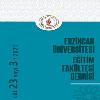Dağıtık Biliş Teorisinin Ders Planında Kullanımı: Teori, Model ve Ders Planı
Dağıtık biliş teorisi, Dağıtık biliş, CTOM modeli, Ders planı
Use of the Distributed Cognition Theory in a Lesson Plan: A Theory, a Model and a Lesson Plan
Distributed Cognition Theory, DCog, CTOM Framework, Lesson Plan,
___
- Bandura, A. (1991). Self-regulation of motivation through anticipatory and self-reactive mechanisms. In R. A. Dienstbier (Ed.), Nebraska Symposium on Motivation, 1990 (Vol. 38, 69–164). Lincoln, NE: University of Nebraska Press.
- Bloom, B.S. (1965). Taxonomy of Educational Objectives: The Classification of Educational Goals. New York: David McKay Company, Inc.
- Driscoll, M.P. (2012). Psychological Foundations of Instructional Design. In Trends and Issues in Instructional Design and Technology. Pearson Education.
- Gagné, R.M. (1985). The conditions of learning and theory of instruction (4th Ed.). New York: Holt, Rinehart and Winston.
- Gardner, H. E. (1999). Multiple Approaches to Understanding. In C.M. Reigeluth (Ed.), Instructional-design theories and models: A new paradigm of instructional theory, Vol.2. Mahwah, NJ: Lawrence Erlbaum Associates.
- Harris, S. (2004). Distributed Cognition. Retrieved November 25, 2015, at: http://mcs.open.ac.uk/yr258/dist_cog/
- Hutchins, E. (1995a). Cognition in the wild. Cambridge, MA: The MIT Press.
- Hutchins, E. (1995b). How a cockpit remembers its speeds. Cognitive Science, 19, 265–288.
- Kaput, J. J. (1992). Technology and mathematics education. In D. A. Grouws (Ed.), Handbook of teaching and learning mathematics (pp. 515–556). New York: Macmillan.
- Martin, L. (2012). Connection, Translation, Off-Loading, and Monitoring: A Framework for Characterizing the Pedagogical Functions of Educational Technologies. Technology, Knowledge and Learning, 17(3), 87–107. doi:10.1007/s10758-012-9193-6
- MEB, Talim Terbiye Kurulu Başkanlığı (2012) Ortaokul ve İmam Hatip Ortaokulu Bilişim Teknolojileri ve Yazılım Dersi Programı ve Kılavuzu, 5,6,7 ve 8. Sınıflar, Ankara.
- Norman, D. A. (1993). Things That Make Us Smart. MA: Addison-Wesley.
- OECD. (2012). How does class size vary around the world?. OECD Factbook 2012. Retrieved from SourceOECD database (http://www.oecd.org/edu/skills-beyond-school/EDIF%202012--N9%20FINAL.pdf).
- Rogers, Y. (1997). “A Brief Introduction to Distributed Cognition,” Discussion paper, Interact Lab, School of Cognitive and Computing Sciences, University of Sussex.
- Vygotsky, L. S. (1978). Mind in society. Cambridge, MA: Harvard University Press.
- Wenger, E. (1999). Communities of practice: Learning, meaning, and identity. Cambridge University Press.
- Wenger, E., McDermott, R., & Snyder, WM (2002). Cultivating communities of practice: A guide to managing knowledge. Boston, MA: Harvard Business School Press.
- Yayın Aralığı: 4
- Başlangıç: 1999
- Yayıncı: Erzincan Binali Yıldırım Üniversitesi
Türkçe Öğretmeni Adaylarının Örgütsel Öğrenme Farkındalığının Geliştirilmesi
Neslihan KARAKUŞ, Celile EREN ÖKTEN
Bülent AKSOY, Taner ÇİFÇİ, Hakan KOÇ
Muhammet İNCEAĞAÇ, Meliha YILMAZ
Pınar Seda ÇETİN, Guluzar EYMUR
Üniversite Öğrencilerinin Değer Yönelimleri İle Psikolojik Dayanıklılık Düzeyleri Arasındaki İlişki
Dağıtık Biliş Teorisinin Ders Planında Kullanımı: Teori, Model ve Ders Planı
Yabancı Dil Olarak Türkçe Öğrenenlerin Yazma Özyeterlikleri ile Yazılı Anlatım Becerileri
